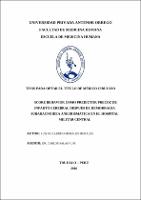Mostrar el registro sencillo del ítem
Score Behavior como predictor precoz de infarto cerebral después de hemorragia subaracnoidea aneurismática en el hospital militar central
| dc.contributor.advisor | Salas Ruiz Carlos | |
| dc.contributor.author | Morales Morales, Luis Guillermo | |
| dc.creator | Morales Morales, Luis Guillermo | |
| dc.date.accessioned | 2017-03-29T16:45:42Z | |
| dc.date.available | 2017-03-29T16:45:42Z | |
| dc.date.issued | 2017 | |
| dc.identifier.uri | https://hdl.handle.net/20.500.12759/2450 | |
| dc.description.abstract | Determinar si el score BEHAVIOR es un predictor precoz de infarto cerebral después de hemorragia subaracnoidea aneurismática en el Hospital Militar Central de Lima durante el periodo de Enero del 2010 a Diciembre del 2015. MATERIAL Y MÉTODO: Realizamos un estudio observacional, analítico, de pruebas diagnósticas, que evaluó 102 pacientes admitidos a UCI por HSA aneurismática, los cuales fueron distribuidos en dos grupos, según la presencia o no de infarto cerebral (45 y 57 pacientes respectivamente). RESULTADOS: La edad promedio en el grupo con y sin infarto cerebral fue 76,51 ± 18,83 y 59,05 ± 21,85 respectivamente (p < 0,001) y la proporción de varones en cada grupo fue 66,67% y 73,68% (p > 0,05). Los scores promedios en cada grupo fueron para HUNT – HESS 4,27 ± 0,50 vs 3,30 ± 0,93, FISHER 2,80 ± 0,73 vs 1,75 ± 0,83 y BEHAVIOR 6,09 ± 1,64 vs 1,86 ± 1,49. La sensibilidad y especificidad para los scores evaluados fueron HUNT –HESS 97,78% y 49,125%, FISHER 62,22% y 85,96% y BEHAVIOR 88,89% y 89,47%; el área bajo la curva para los scores mencionados fueron para HUNT-HESS 0,793, FISHER 0,820 y BEHAVIOR 0,954. CONCLUSIONES: El score BEHAVIOR fue el mejor score para predecir infarto cerebral en pacientes con hemorragia subaracnoidea aneurismática. | es_PE |
| dc.description.abstract | To determine if the score BEHAVIOR is an early predictor for cerebral infarction after aneurysmal subarachnoid hemorrhage in the Central Military Hospital in Lima during the period January 2010 to December 2015. MATERIAL AND METHODS: We conducted an observational, analytical, diagnostic test study, which evaluated 102 patients admitted to the ICU for aneurysmal SAH, which were divided into two groups according to the presence or absence of cerebral infarction (45 and 57 patients respectively). RESULTS: The mean age in the group with and without cerebral infarction was 76.51 ± 18.83 and 59.05 ± 21.85 respectively (p < 0.001) and the proportion of men in each group was 66.67% and 73.68 % (p > 0.05). The mean scores in each group were to HUNT - HESS 4.27 ± 0.50 vs 3.30 ± 0.93, FISHER 2.80 ± 0.73 vs 1.75 ± 0.83 and BEHAVIOR 6.09 ± 1.64 vs 1.86 ± 1.49. The sensitivity and specificity were evaluated for scores HUNT HESS 97.78% and 49.125%, FISHER 62.22% and 85.96% and BEHAVIOR 88.89% and 89.47%; the area under the curve for the above scores were for HUNT-HESS 0.793, FISHER 0.820 and BEHAVIOR 0.954. CONCLUSIONS: The best score was BEHAVIOR to predict cerebral infarction after aneurysmal subarachnoid hemorrhage. | en_US |
| dc.description.uri | Tesis | es_PE |
| dc.format | application/pdf | es_PE |
| dc.language.iso | spa | es_PE |
| dc.publisher | Universidad Privada Antenor Orrego - UPAO | es_PE |
| dc.relation.ispartofseries | T_MED_1943 | |
| dc.rights | info:eu-repo/semantics/openAccess | es_PE |
| dc.source | Universidad Privada Antenor Orrego | es_PE |
| dc.source | Repositorio Institucional - UPAO | es_PE |
| dc.subject | Infarto cerebral | es_PE |
| dc.subject | Score Behavior | es_PE |
| dc.title | Score Behavior como predictor precoz de infarto cerebral después de hemorragia subaracnoidea aneurismática en el hospital militar central | es_PE |
| dc.type | info:eu-repo/semantics/bachelorThesis | es_PE |
| thesis.degree.level | Título Profesional | es_PE |
| thesis.degree.grantor | Universidad Privada Antenor Orrego. Facultad de Medicina Humana | es_PE |
| thesis.degree.name | Médico Cirujano | es_PE |
| thesis.degree.discipline | Medicina Humana | es_PE |
Ficheros en el ítem
Este ítem aparece en la(s) siguiente(s) colección(es)
-
Medicina Humana [2739]

